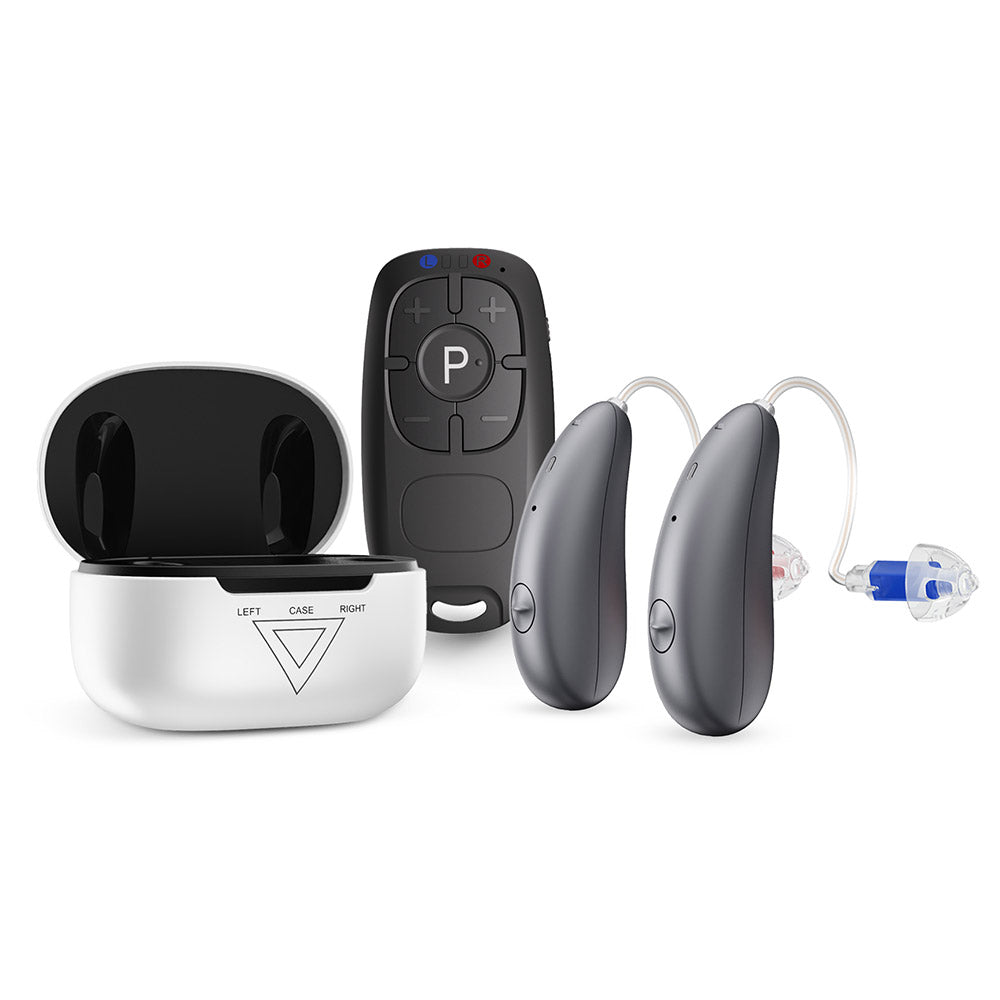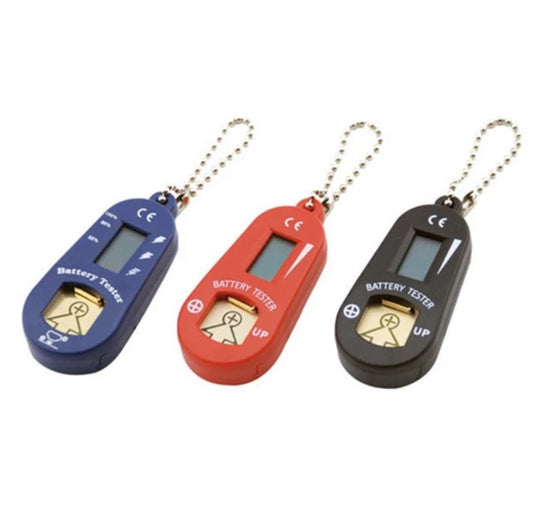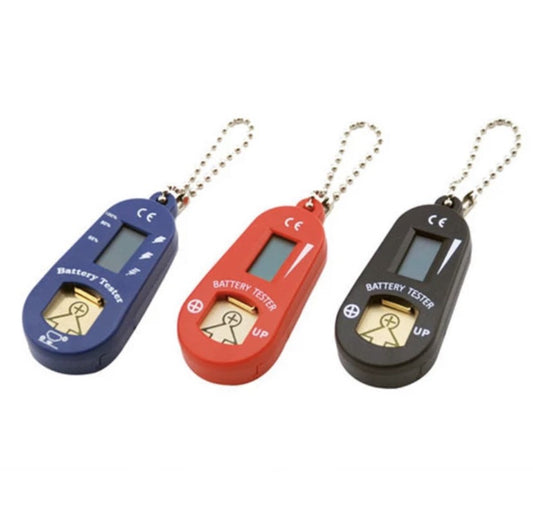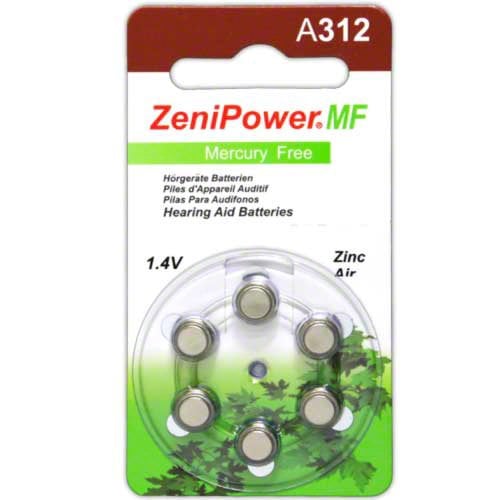Collection: Hearing Aid Batteries
Order Your Hearing Aid Batteries Online Today
-
Hearing Aid Battery Tester
Vendor:PocketAidRegular price £5.00 GBPRegular priceUnit price / per -
Zeni Power - Size 312 Batteries
Vendor:PocketAidRegular price £1.50 GBPRegular priceUnit price / per -
Zeni Power - Size 10 Batteries
Vendor:PocketAidRegular price £1.50 GBPRegular priceUnit price / per

Buying a PocketAid™ is Risk Free

30 Day Money-Back Guarantee

Free Fast Delivery Across the UK

3 Year Warranty on All Hearing Aids

Customer Service Guarantee
Whether you prefer rechargeable hearing aids or those with disposable hearing aid batteries, finding the right option shouldn’t be complicated or costly. At PocketAid, we offer both rechargeable hearing aids and battery-powered hearing aids.
In addition to batteries, hearing aid accessories such as battery testers, cases, and cleaning tools are available.
Types of Hearing Aid Batteries - rechargeable vs disposable hearing aid batteries
There are two main types of batteries to consider – disposable batteries and rechargeable batteries. The right choice often depends on your lifestyle, dexterity and how much you value convenience vs. ongoing cost.
Capacity is another important factor, as disposable batteries and rechargeable batteries differ in how much power they can store and how long they last between changes or charges. Higher capacity batteries can support longer usage, especially if you stream audio frequently or have more power-hungry devices.
Ultimately, it's important to choose the most suitable battery type for your specific needs and requirements.

Disposable Zinc Air Batteries
These are the traditional, button-style batteries most people are familiar with. Zinc air batteries operate by using oxygen from the air to generate power. They’re air-activated, meaning they start working as soon as you remove the sticky tab.
-
Pros
- Widely available
- Easy to carry spare batteries when travelling.
-
Cons
- Frequent replacement required
- Can be tricky to handle for those with dexterity or vision issues
- Long-term cost adds up

Rechargeable Lithium-Ion Batteries
Modern rechargeable hearing aids use built-in batteries you don’t need to remove or replace. Just dock the hearing aids into a charging case.The average lifespan of rechargeable lithium-ion batteries in hearing aids is typically around 3 to 5 years .
-
Pros
- No more buying or fiddling with batteries
- Safer around kids and pets (no small parts to swallow)
- Ideal for people with dexterity or sight challenges
- Better for the environment
-
Cons
- You need to remember to charge daily
- Slightly higher upfront cost (offset by no recurring battery purchases)
- You need to remember to charge daily
Battery Brands: What to Look For and Top Choices
Choosing the right brand can make a significant difference in both performance and convenience. Leading brands like ZeniPower, Duracell, Rayovac, and Energizer are trusted for their reliability and offer a wide range of hearing aid batteries in various sizes, including size 10 and 312. These brands are known for producing high-quality options, which have a long shelf life.
If you’re looking for a more sustainable and convenient option, many top brands now offer rechargeable hearing aid batteries. This rechargeable technology not only reduces waste but also saves you time and money over the long run. Whether you prefer the convenience of rechargeables or the flexibility of disposables, selecting a reputable brand ensures your hearing aid will deliver reliable sound and good battery life. Always check that the option you choose is compatible with your specific hearing aid model and size for the best results.
PocketAid Hearing Aid Battery Solutions
Disposable hearing aid batteries: Affordable, easy-to-find zinc air batteries are just £1.50 GBP for a 6-pack for PocketAid customers. PocketAid offers batteries compatible with various hearing aid models and battery sizes, ensuring you find the right fit for your device.
- Size 10 (yellow): for PocketAid Spot Mini 6
- Size 312 (brown): for PocketAid Jaspa 3 BTE
Hearing aid batteries come in four sizes (10, 13, 312, 675), and choosing the correct battery size is essential for different hearing aid models, including behind-the-ear hearing aids. These different sizes are standardised to match the sizes of hearing aids and ensure optimal performance.
Larger batteries tend to last longer and are used in certain hearing aid models.
What you’ll need:
- Spot Mini 6 – Size 10 (2–3-month supply included with purchase)
- Jaspa 3 BTE – Size 312 (6-week supply included with purchase)
Our devices using disposable batteries offer:
- Secure battery compartment with a tight-sealing latch
- Batteries stay firmly in place, even if the aid is dropped.
Rechargeable Models: The Diamond Stream 12 or Jaspa 3 Dura contain fully rechargeable, lithium-ion batteries providing up to 20 hours of use from a single charge and come with a magnetic charging case.
Whether you prefer the simplicity of rechargeables or the familiarity of traditional batteries, we give you the freedom to choose without clinic mark-up.
Curbing the hidden cost of disposable hearing aid batteries
When we think of buying hearing aids, we usually consider the initial, upfront cost.
Most rechargeable options come with a higher price tag, so the traditional disposable battery models may seem more tempting. However, it's important to factor in the ongoing cost of standard hearing aid batteries, which need to be replaced regularly.
But have you ever done the sums on the ongoing costs? Most hearing aids use standard hearing aid batteries, and their replacement is a recurring expense that adds up over time.
Wait! How often do you need to change hearing aid batteries?
It might surprise you to know that hearing aid batteries usually only last between 5 and 14 days before they need to be replaced once their lifespan ends.
You’re going to be going through quite a lot of them, fast, so you need to factor the ongoing cost into your choice of hearing aid.
Let’s do the maths:
Say you need to swap out your batteries roughly every 5 days × 365 = 73 batteries a year. Since they usually come in packs of 6, that’s just over 12 packs per year or 36 packs over 3 years.
So, what’s all that going to cost you?
Let’s take a look at how PocketAid compares to some of the major UK battery suppliers.
UK Price Comparison* (GBP): Size 312 Hearing Aid Batteries
(*Assumes one battery change every 5 days = approx. 73 batteries/year = ~12.2 packs/year. Advertised prices in August 2025).
Popular brands like Duracell hearing aid batteries, ZeniPower hearing aid batteries and Rayovac hearing aid batteries are widely available from online retailers, making it easy to compare prices and find the best deals.
| Provider / Source | Price per 6-pack | Annual Cost | 3-Year Cost |
|---|---|---|---|
| PocketAid | £1.50 | £18.30 | £54.90 |
| BatteryStation.co.uk (Rayovac) | £1.69 | £20.62 | £61.86 |
| Boots Hearingcare | £1.70 | £20.74 | £62.22 |
| HAB Hearing (Rayovac) | £1.95 | £23.79 | £71.37 |
| London Hearing Specialist | £3.95 | £48.19 | £144.57 |
| Duracell (GoGreen) via YourSpares | £6.28 | £76.62 | £229.86 |
Over just 3 years, PocketAid users can save up to £175 GBP compared to buying hearing aid batteries from other retailers. We’ve answered the call for cheap hearing aid batteries in the UK.
Even when compared to mid-range retailers, PocketAid still offers savings of around £7 to £10 GBP every year.
These small savings per pack quickly add up, especially if you wear hearing aids in both ears or you’re helping a family member manage their hearing care.
Affordable Hearing Aid Battery Prices – No Surprises
Unlike many private hearing clinics in the UK, at PocketAid we believe in upfront pricing, accessible hearing and zero surprises when it comes to the cost of ownership.
Because here’s the reality:
When purchasing hearing aids through a private clinic, you’ll often discover that you’re locked into their supply chain and that’s where the real costs begin.
- Most clinics don’t clearly advertise the price of replacement batteries.
- Some only sell them in-store, at inflated prices.
- You may be encouraged to sign up for auto-shipping or battery clubs that make it hard to opt out.
- And all of this is happening after you’ve spent thousands of pounds on your hearing aids.
It can come as a shock to find out that those impressive new aids come with years of hidden costs for something as basic as keeping them running. Buyers of new hearing aids should also be aware of the ongoing battery costs that can add up over time.
At PocketAid, it’s different
We don’t make our money by charging premium prices for the basics, again and again.
Our Size 312 hearing aid batteries and Size 10 hearing aid batteries are just £1.50 GBP for a pack of six, available anytime on our Extras Shop.
No subscription traps. Just clear, fair pricing and the best hearing aid batteries delivered direct to your door.
Why? Because our goal isn’t to trap you into a long-term payment cycle. It’s to make hearing easier, more affordable and more transparent – from day one.
So, whether you’re buying for yourself or supporting a loved one, you can do so confidently, knowing exactly what to expect – not just at the checkout when buying your preferred device, but for years to come.

Caring for the planet
If you choose a device using disposable hearing aid batteries, there are easy and eco-friendly ways to dispose of them responsibly.
Safe Battery Recycling
-
Don't Bin Them
Improperly disposed hearing aid batteries can spark fires if crushed in waste trucks and leak toxic metals like lead and mercury into the environment. Damaged batteries also pose safety risks to waste workers and contribute to long-term pollution. Safe recycling is essential.
-
Tape Them
If the terminals of the batteries touch each other or metal surfaces, they can spark and ignite. To avoid this, it’s important to tape over the terminals of used batteries before recycling them. Button hearing aid batteries should be taped on all sides.
-
Drop Them Off
The UK has a wide and growing network of hearing aid battery recycling options, including Battrecycle which is a nationwide initiative.
Storing Batteries: Keeping Your Power Fresh and Safe
Proper storage is key to getting the most out of your hearing aid batteries. To extend their lifespan and maintain reliable power, always store your aid batteries in a cool, dry place, away from direct sunlight, extreme temperatures, and sources of moisture. Avoid keeping them near metal objects like keys or coins, as contact with metal can cause them to discharge or even short-circuit.
Never store your batteries in the refrigerator or freezer, as condensation can damage them and reduce their effectiveness. When your hearing aid isn’t in use for an extended period, remove the batteries and keep them in a protective case or container. Handle batteries gently and with clean, dry hands to prevent any accidental damage. By following these simple storage tips, you’ll help ensure your hearing aid batteries stay fresh, safe, and ready to deliver reliable power whenever you need it.
Dexterity or vision issues? We have the solution
We understand that handling tiny disposable hearing aid batteries isn’t easy for everyone.
If you live with dexterity or vision issues, or even simply reduced finger strength, you’re not alone. Small batteries can be fiddly, frustrating and all too easy to drop. With newer advancements, smaller batteries are now common, but they can be especially difficult to handle for those with dexterity or vision issues. For some, even peeling off the activation tab can be a challenge.
Our hearing aid selection tool can help you find the perfect hearing aid for you.
If you’ve ever had to get down on your hands and knees looking for a battery that’s rolled away, worried that a grandchild or pet might swallow it, you know how anxiety-inducing it can be.
PocketAid gives you the option to do away with tiny, replaceable batteries altogether with our rechargeable hearing aids the Diamond Stream 12 or Jaspa 3 Dura devices.
Bluetooth streaming and battery drain
If you're planning to stream music, take calls or watch Netflix using your hearing aids, you're probably wondering if that constant Bluetooth connection will wear your battery down too fast.
Designed for streaming without the battery panic
The Diamond Stream 12 has been purpose-built for Bluetooth performance. That means:
- Efficient power usage while streaming so you can enjoy audio without constantly checking battery levels.
- Need a fast boost? Just 15 minutes of quick charging gives you around 8 hours of use, perfect for busy mornings.
- And best of all, it takes less than two hours to fully charge the device
- So yes, you can comfortably stream your favourite playlists, take long phone calls or scroll through social media videos without worrying you'll run out of power halfway through the day.
Your Charging Case: Smart, Magnetic, and Ready to Travel
We’ve also packed some thoughtful extras into the Diamond Stream 12's charging case.
The included portable charging case doubles as a power bank, holding enough charge for three full top-ups without needing a wall socket.
That’s up to 72 hours of total listening freedom, wherever life takes you.
So even if you forget to plug into the wall every night, your case has your back.
With the Diamond Stream 12, you’ll likely forget battery anxiety ever existed. You just charge it like your phone and then get on with your life
Hearing Aid Maintenance and Accessories
Keeping your hearing aid in good condition is essential for longer battery life. Regular maintenance starts with cleaning your device and checking the battery compartment for any dust or debris that could interfere with battery contact. Moisture is a common enemy of hearing aids, so consider using a hearing aid dryer or dehumidifier to keep your device dry, especially overnight.
Always use the correct battery type and size recommended for your hearing aid model, using the wrong one can affect performance or even cause damage. Rechargeable hearing aid batteries are a convenient and cost-effective option, reducing the need for frequent replacements and making daily use simpler. Accessories like sturdy hearing aid cases and specialised hearing aid cleaning tools can further protect your hearing aid and extend its life. By making maintenance and the right accessories part of your routine, you’ll enjoy clear sound and dependable performance every day.
Frequently Asked Hearing Aid Battery Questions
How long do hearing aid batteries last?
Hearing aid batteries (Size 312 & Size 10) typically last 5–14 days.
Does streaming via Bluetooth drain batteries faster?
In general, yes. However, PocketAid’s Bluetooth model, the Diamond Stream 12 is optimised for Bluetooth, and quick boosts of 8 hours from a 15-minute charge.
How can I make hearing aid batteries last longer?
Let the battery air-activate for 1–2 minutes before inserting it and switch your aids off or open the battery door when not in use. Store them in a cool, dry place and handle them with clean, dry hands to preserve performance.
Are Hearing Aid batteries all the same?
Hearing aid batteries are universal in size and type, which means you don’t need to buy a specific brand just because of the hearing aid you use. Whether you’ve got a device from PocketAid or any other brand, if it takes a Size 312 or Size 10 battery, any reputable battery in that size will work. What varies is the price you pay, not the performance. At PocketAid, we offer the same trusted zinc-air batteries you’ll find in clinics and pharmacies, but at a fraction of the cost – just £1.50 GBP for a 6-pack.
Can I recycle my hearing aid batteries?
Absolutely. Most UK supermarkets, pharmacies and council recycling centres offer free drop-off bins for used batteries. Consider rechargeable models to reduce landfill waste altogether.
What is a rechargeable battery lifespan in hearing aids?
Rechargeable lithium-ion batteries in PocketAid devices are designed to hold a full day’s power and typically last 4–6 years before needing replacement. Over time you may notice slightly reduced battery life. We can help with phone support and warranty service.
What if I have trouble handling small hearing aid batteries?
Disposable batteries are tiny and tricky if you have dexterity or vision issues. PocketAid offers rechargeable options like Diamond Stream 12 and Jaspa 3 Dura with magnetic charging docks for easy handling.
What do I do if battery performance suddenly drops?
First, check audio quality. Weak or distorted sound or the device turning off are clear signs. For disposable battery devices, try inserting a fresh, air-activated battery and clean the contacts. If the performance issue continues, get in touch. PocketAid offers replacements as well as online troubleshooting and phone customer service and support.
Conclusion: Powering Your Hearing Journey
Choosing the right hearing aid battery and caring for your hearing aids are essential steps in ensuring clear, reliable hearing every day. By selecting a trusted battery brand, storing your batteries properly, and following a regular maintenance routine, you’ll maximise battery life and enjoy optimal performance from your hearing aid. Don’t forget to take advantage of available resources, such as free online support, to make your hearing journey even smoother.
Whether you rely on disposable or rechargeable hearing aid batteries, prioritising proper care and maintenance will help you get the most out of your device. Always follow your manufacturer’s instructions and reach out to your hearing aid provider with any questions. With the right battery and a little attention to maintenance, you’ll stay connected, confident, and ready to enjoy all the sounds life has to offer.





